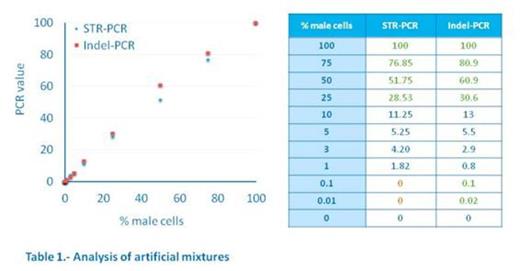Abstract
Introduction
Post-hematopoietic stem cell transplantation (SCT) chimerism monitoring is important to assess engraftment, anticipate relapse and provide information on the development of graft versus host disease, facilitating therapeutic intervention. The aim of this study was to test the technical efficacy and clinical utility of a novel quantitative PCR approach targeting insertion/deletion polymorphisms (indel-PCR).
Materials (or patients) and methods
This study included 157 samples (81 bone marrow, 60 peripheral blood (PB), 11 T-cells, 2 myeloid cells, 2 CD34-cells, 1 NK-cells purified using immunomagnetic technology) of 24 patients who underwent SCT for haematological malignancies. Additionally, 2 sets of 11 artificial mixtures were created using PB leukocytes of two healthy subjects (a male and a female) with known percentages of male leukocytes (putative recipient): 100, 75, 50, 25, 10, 5, 3, 1, 0.1, 0.01, 0.
Chimerism analysis was performed by the gold-standard STR-PCR (AmpFlSTR SGM Plus®, Life Technologies, USA) and by indel-PCR (Mentype® DIPscreen, Mentype® DIPquant, Biotype, Germany). Concordance between both methods was calculated with SPSS using intraclass correlation coefficient.
Results
The number of informative loci identified with indel-PCR (>3/patient) was higher than with STR-PCR for all patients.
Concordance between both methods for the 157 patient samples and 11 artificial mixtures was "very good" (intraclass correlation coefficient=0.96). Of note, analysis of artificial mixtures provides evidence of significantly (≥2 logs) higher sensitivity by indel-PCR (0.01%) than by STR-PCR (1%, Table 1). Moreover, indel-PCR shows unprecedented quantification capacity (Table 1). Out of the 168 samples analyzed, 32 were positive and 15 negative by both methods, while 121 were positive only by indel-PCR (95% with <1% recipient).
Clinical outcome and chimerism dynamics of 24 patients are described in figure 1, data of 4 of them were censored (engraftment failure, disease progression, insufficient number of samples). All the samples presented complete donor chimerism by STR-PCR. Of the 9 patients who showed stable or decreasing percentage of recipient cells, only one (11%) presented extramedulary relapse. Of the 11 patients who presented increasing percentage of recipient cells in one determination, relapse occurred in 5 patients (45%, 3/6 patients who did not have further determinations, 2/4 who showed stable or decreasing recipient cell percentage, and 0/1 patient who presented increasing recipient cells in subsequent determinations).
Conclusion
This novel indel-PCR is a simple and accurate technique that, in comparison with the current gold standard STR-PCR, shows very good concordance and provides higher rates of informative loci per patient, as well as unprecedented combined sensitivity and quantification capacity. Such features allow minutely monitoring chimerism dynamics and might improve clinical management of transplanted patients, specially predicting relapse in those patients who do not have a molecular marker available for disease follow up.
No relevant conflicts of interest to declare.
Author notes
Asterisk with author names denotes non-ASH members.



This feature is available to Subscribers Only
Sign In or Create an Account Close Modal